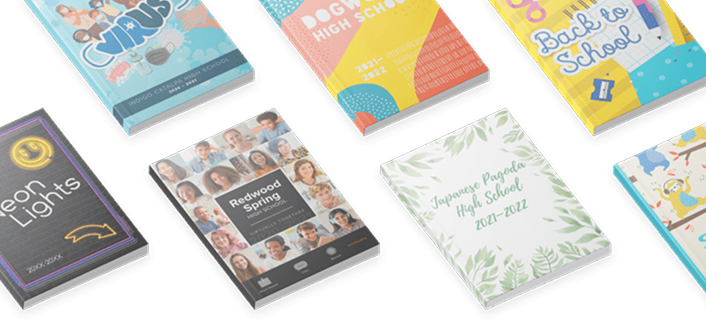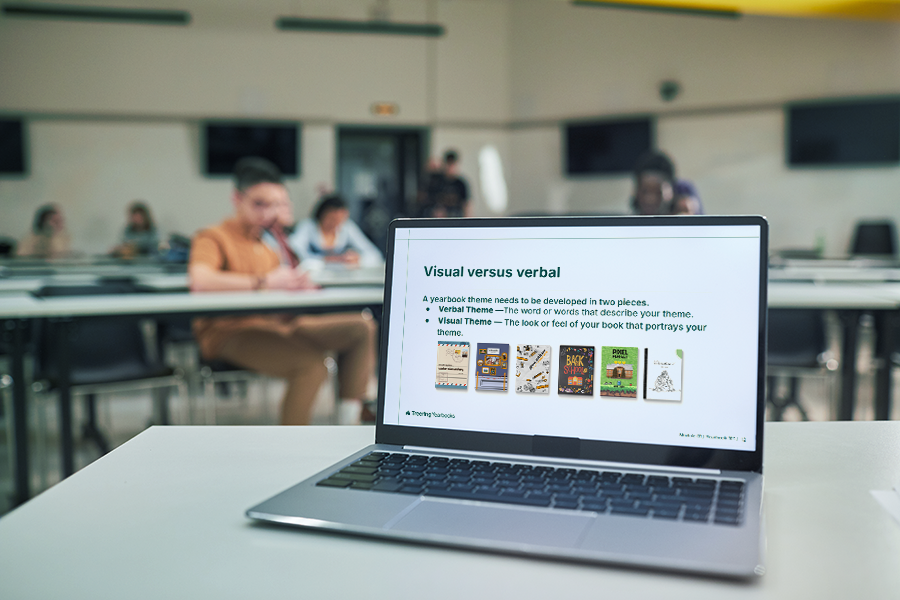Most popular
Subscribe to our blog
Most recent

65 academics headlines for yearbook
Your academics section needs stronger headlines. Agreed? The headline on each yearbook spread influences the reader's scanning behavior. (Read: it makes buyers look at your hard work.) When skimming a spread, the eye is naturally drawn to the headline first, and from there, it can guide the reader to other important elements such as subheadings, captions, and images. While headlines traditionally are larger text, additional design elements such as type treatments and mixed fonts help also set them apart. Below are the why, how-to, and 65 examples of headlines you can use in your yearbook.
How to Write Captivating Headlines
It’s easy to drop football or science fair at the top of your yearbook spread. For those looking to up their writing game, crafting journalistic, punny, or thematic headlines can enhance your yearbook storytelling.
Not sure where to begin? Use some of the academics-centric headlines below to inspire or jumpstart your writing process.

STEM Headlines
- Calculating the Memories
- Chart a Force
- [Mascots] Count Get Enough
- Easy as Pi
- Formula for Fun
- Here Comes the Sum
- In Our Prime
- Make Sum Noise
- Massing Around
- On this Equation
- Pi-ous Celebration
- Rule for Thought
- Square One: [Year]
- Squaring Is Caring
- The Final Equation
- The Sum of [Year]
- Up and Atom
- Write Angle
Humanities Headlines
- Act your Page
- Anything Prose
- Blurb the Line
- Bookmark my Words
- Born and Read
- Bursting at the Themes
- Do the Myth
- Full Theme Ahead
- Get Booked On
- Go for Baroque
- Move in the Right Direction
- Plot it Down
- Prose and Cons
- A Rhyme a Dozen
- Setting Pretty
- Strike a Prose
- The Write Stuff
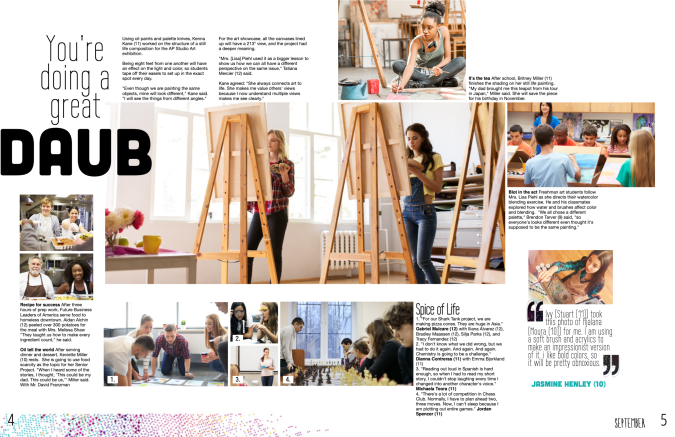
Arts Headlines
- All Hands on Deco
- All Strings Considered
- Band New
- Band Over Backwards
- Bright of Passage
- Brush with Greatness
- Canvas of the Year
- Choral High Ground
- Emboss Level
- Face the Music
- Fair and Snare
- Fluid for Thought
- Hip Hop to It
- Horn to Fly
- Rhythm and Reflection
- Size the Day
- Soul in One
- The Stage is Set
Senior Section Headlines
- A Class Act
- A Degree of Fun
- From Student to Scholar
- Looking Grad-ulous
- Making Moves
- Onward and Upward
- Rising to the Challenge
- Stepping Into New Horizons
- Taking Flight (good for a bird mascot)
- The Final Exam
- The Final Lap of our Academic Race
- The Future Begins

Vacation vibes: take a yearbook breather with beach reads and podcasts
As any yearbook adviser will likely concur, one of the most beautiful sights on the internet is the celebratory confetti that fills your screen when you hit “print ready.” Now that summer break is underway and your yearbook has gone to print, it’s time to indulge in well-deserved relaxation. Whether you're opting for a tropical vacation or a cozy staycation, the Treering team has curated a selection of delightful beach reads and captivating podcasts to enhance your leisure time.
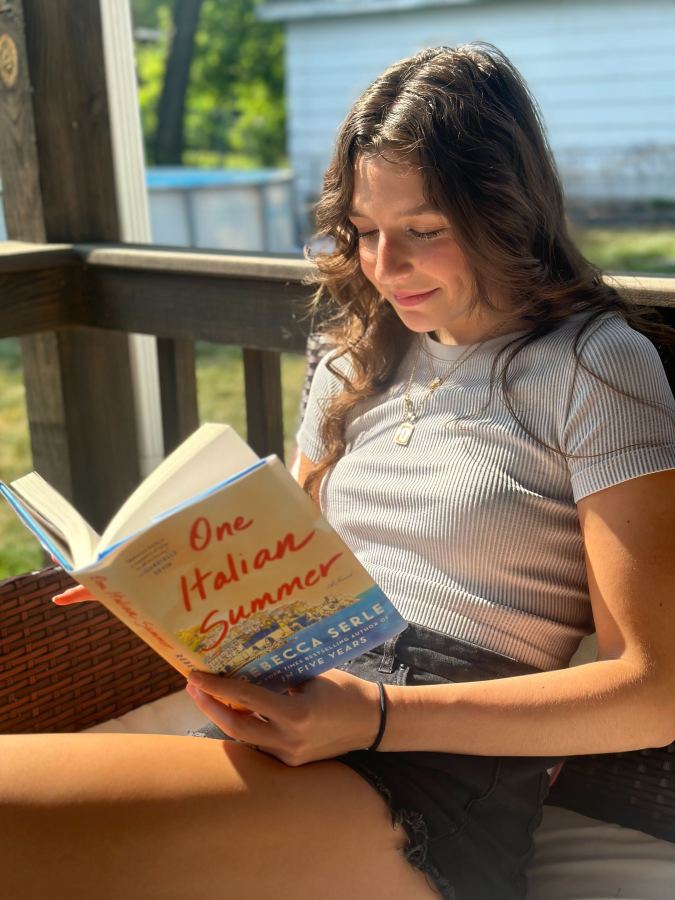
Beach Reads to Dive Into
If you're an avid reader with a never-ending list of books to conquer, now is the perfect time to get caught up in a good read. Here are a few to add to your shortlist:
- One Italian Summer by Rebecca Searle (recommended by Chrissy K., Customer Success Manager): A 30-year-old married woman from Los Angeles, finding herself adrift after her mother’s death, travels to Italy on a long-awaited vacation they had planned to take together. (Kirkus Reviews)
- Trust by Hernan Diaz (recommended by Bobby H., Head of Growth): A riveting novel set in a bygone America that explores family, wealth, and ambition through linked narratives rendered in different literary styles, a complex examination of love and power in a country where capitalism is king. (The Pulitzer Prizes)
- Then She Was Gone by Lisa Jewell (recommended by Ayesha M., Sales Development Representative): Ten years after her teenage daughter disappears, a woman crosses paths with a charming single father whose young child feels eerily familiar... (Greenwich Library)
- The Joy Luck Club by Amy Tan (recommended by George K., Head of Product): In 1949, four Chinese women, recent immigrants to San Francisco, begin meeting to eat dim sum, play mahjong, and talk. United in shared unspeakable loss and hope, they call themselves the Joy Luck Club. Rather than sink into tragedy, they gather to raise their spirits and money. (Amazon)
Poolside Podcasts
If you prefer to relax with headphones by the pool, here are some podcast recommendations that are sure to pique your interest:
- Gee Thanks. Just Bought It! hosted by Caroline Moss (recommended by Megan P., Marketing Manager): Ever bought something you loved SO much that you couldn't stop telling everyone about it? Los Angeles-based writer and host Caroline Moss invites interesting, smart, and savvy guests to evangelize their favorite buys in the hopes of helping you become a smarter and more informed shopper.
- The Way I Heard It, hosted by Mike Rowe (recommended by Erin M., Sales Development Representative): From pop culture to politics, history to Hollywood, each mystery is a true-ish tale about someone you know, filled with facts that you don’t. Delivered with Mike’s signature blend of charm, wit, and ingenuity, these stories are part of a larger mosaic—full of surprising revelations, sharp observations, and intimate, behind-the-scenes moments drawn from Mike’s life and career.
- On Purpose, hosted by Jay Shetty (recommended by Shannon H., Sales Development Representative): Jay Shetty’s purpose is to make wisdom go viral. His podcast brings fascinating conversations with some of the most insightful people in the world straight to viewers worldwide.
- Hey Dude… the 90s Called, hosted by Nickelodeon child stars David Lascher and Christine Taylor from the cult classic show Hey Dude (recommended by Erika Lin P., Marketing Manager): You won’t be Clueless about your favorite shows when the crew from West Beverly and Bayside High, among others, share gossip, coming of age takes, on set challenges, and fan encounters.
Embrace the Vacation Vibes
Whether you prefer turning the pages of a good book or immersing yourself in a fascinating podcast, we hope these suggestions enhance your well-deserved break from yearbook responsibilities. (If you can’t help yourself, check out this Summer Yearbooking blog.)
Happy Summer!
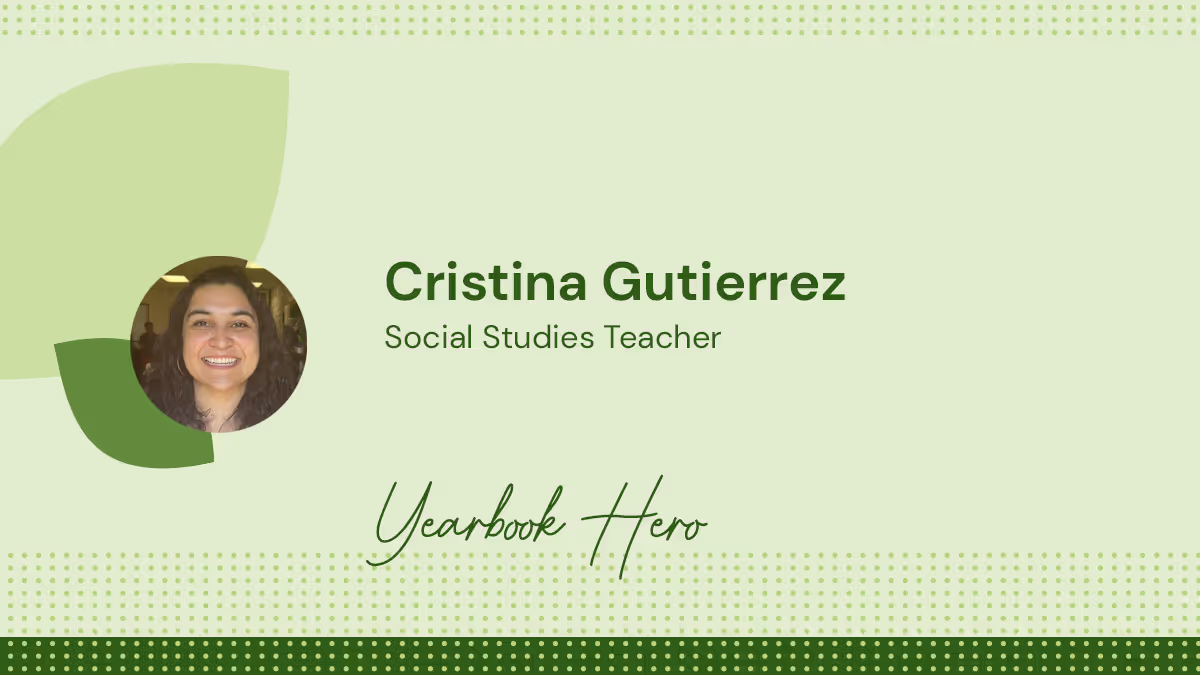
Yearbook Hero Cristina Gutierrez
Treering Yearbook Heroes is a monthly feature focusing on yearbook tips and tricks.
In San Mateo, California, a group of remarkable students has embarked on an extraordinary journey. Led by their passionate social sciences teacher Cristina Gutierrez, the diverse group at San Mateo Union High School Bridge program (SMUHSD Bridge) is not only learning English and striving to complete their high school education but also making history by creating their school’s inaugural yearbook.
What made you decide to start a yearbook program this year?
We started the program so our students could have something physical to remember all the unique memories and memorable moments in our Bridge program. As they move on in life, I want them to be able to hold onto that joy.
Our students face challenges above and beyond most high school students. Most are unaccompanied newcomers from Central America: Guatemala, El Salvador, Honduras, and Mexico, and many come to the U.S. to flee violence or to reunite with a family member. Students range in age from 16 to 18, and 95% also work full-time to support family in their home countries. We wanted a way to empower them to showcase their experiences, culture, and dreams.
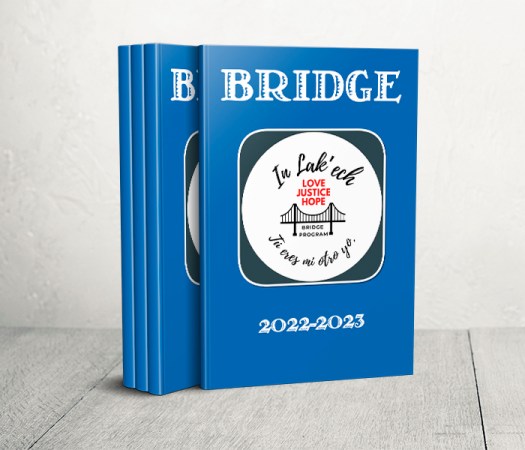
What activities, events, and programs did you cover in the 2022-2023 yearbook?
Every day at Bridge is different and exciting, so we tried to showcase all our diverse activities in our yearbook. We covered the fiestas we held, Independence Day for some students' home countries, Halloween, various award ceremonies, field trips, and English Learner Development classes. Our soccer league even won the championship in May! And, of course, we covered the people who make up Bridge: our staff and students. We honored our graduating seniors with recognition pages. They deserve all the accolades!
Our school’s philosophy and teachings are grounded In Lak’ech pedagogy, a Maya affirmation that roughly translates to “you are my other me,” it focuses on prioritizing our relationships and responsibility to one another to foster a supportive learning community. We included In Lak’ech in our yearbook to memorialize our learnings.
How did the students participate in creating the yearbook?
Our independent studies students worked together to create the yearbook. Treering’s crowdsourcing made it easy to grab photos from across the school. Working on this project was a hands-on way to teach students valuable skills like graphic design, storytelling, and photography to use later in life. It was also great to see students reminisce about our different events in the past while creating the yearbook.
What is the most memorable thing about your yearbook?
Our program is constantly growing in numbers, and throughout the year, we are continually adding new students to our Bridge family. It’s never too late to join the program. We captured much of our year with Treering’s later deadlines, but even students who arrived in the last month of school were still thrilled to receive a copy of the yearbook and hold on to those memories. Their excitement shows how powerful a yearbook can be - it keeps students excited for future years’ memories and gives them a physical treasure to take home.
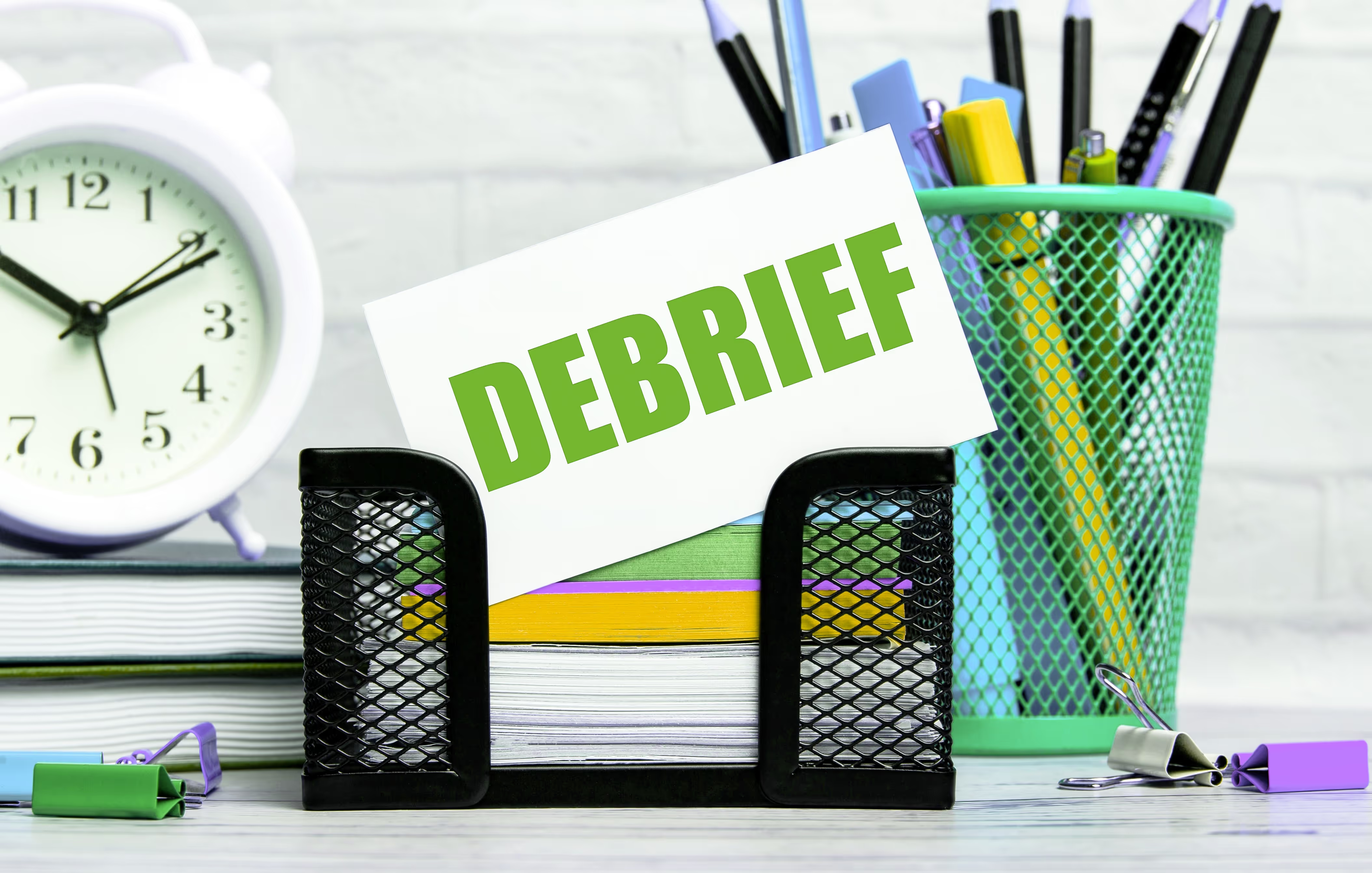
Yearbook debriefing: a summer reflection
Now that your yearbook is a wrap and there’s nothing but sunshine ahead, it’s nice to take some time to reflect on your achievement. You may not want to spend all summer analyzing your yearbook (and who does?), but here are some quick "yearbook debriefing" tasks to help set yourself up for the new school year:
Bask in your success.
You did it! We hope you feel accomplished, proud, and gratified. First and foremost, this is the perfect time to round up your team to celebrate a job well done. Whether it’s a picnic in the park, a backyard super soaker battle, a trip to a local amusement park, or a pizza party at the pool, gathering everyone together is a great way to close this chapter (pun intended!).
A shared celebration is a morale boost, a “thank you,” and a fantastic way to show everyone how fun yearbooking is as you ride that wave of camaraderie into the upcoming year.
Solicit and evaluate feedback.
Whether utilizing an informal compilation of comments or a more formal survey or meeting, it’s helpful to evaluate the yearbook from the experience of your school community. This process can include everything from design and content to distribution and will be invaluable during your yearbook debriefing.
While we all would prefer kudos to criticism (here are some tips for dealing with complaints), your audience's honest feedback is crucial to improving and enhancing your yearbook program. Additionally, considering suggestions and allowing people to feel heard goes a long way toward creating a solid yearbook culture.
Analyze growth opportunities.
When doing your yearbook debriefing, looking for ways to refine your process is essential. Did you and your team encounter any challenges building or marketing your book? Can you enhance your collaboration process? Is there room for improvement in your workflow or organization? If your timeline proved challenging, have you considered a company that allows you to control your deadline?
Lay the fall foundation.
Remember to take a few minutes to set yourself up for fall success by verifying details with your publisher (e.g., logging in to confirm your account for next school year). And if you would like to spend some time planning for your next yearbook over the summer, here are three steps to kick off another fantastic year of capturing your school’s spirit. Here’s hoping you can do all your prep work poolside!

Artificial intelligence (ai): assuring safe memories
As Artificial Intelligence (AI) inspires nearly all facets of daily life, today’s news focuses heavily on buzzy AI tech like the ubiquitous ChatGPT. From improving the travel, automotive, and healthcare industries to monitoring coral reefs, the benefits of AI seem limitless. (You can even ask for curated movie recommendations!) The yearbook world, of course, is no exception.
Treering’s in-house engineers constantly strive for ways to improve and innovate the yearbook experience for everyone involved, and our AI-driven content review process is doing just that. Here are some ways employing this exclusive technology has helped protect cherished memories for the past several years and counting:
Streamlining the Review Process
One yearbook challenge editors are all-too-familiar with is ensuring that inappropriate content doesn’t make its way onto pages (or worse, the news).
To solve this, Treering implements our automated AI review pipeline before going to print. This process efficiently moderates a book’s content across a network of computers that wield industry-leading and constantly evolving computer vision.
Free Time for Editors
Treering’s AI can swiftly and accurately analyze vast volumes of data (1,430,921 pages year to date, in fact!), flagging them as necessary for review and follow-up. This process allows teams to focus more time and attention on tasks that can’t be automated, like matching students with a stellar list of yearbook superlatives.
Offering the Best of Both Worlds
Of course, the human component remains a vital part of the yearbook review. (Treering loves a good collaboration!) In addition to utilizing AI, we employ staff dedicated to this process.
When teams combine Treering’s content review procedure with other proofing tools, such as our free printed proof, schools can relax, knowing they’ll immortalize the best possible yearbook version.
The applications of artificial intelligence are plenty, and Treering is proud to pioneer its use to proactively benefit schools by making it easier and safer for students and families to capture life’s memories.
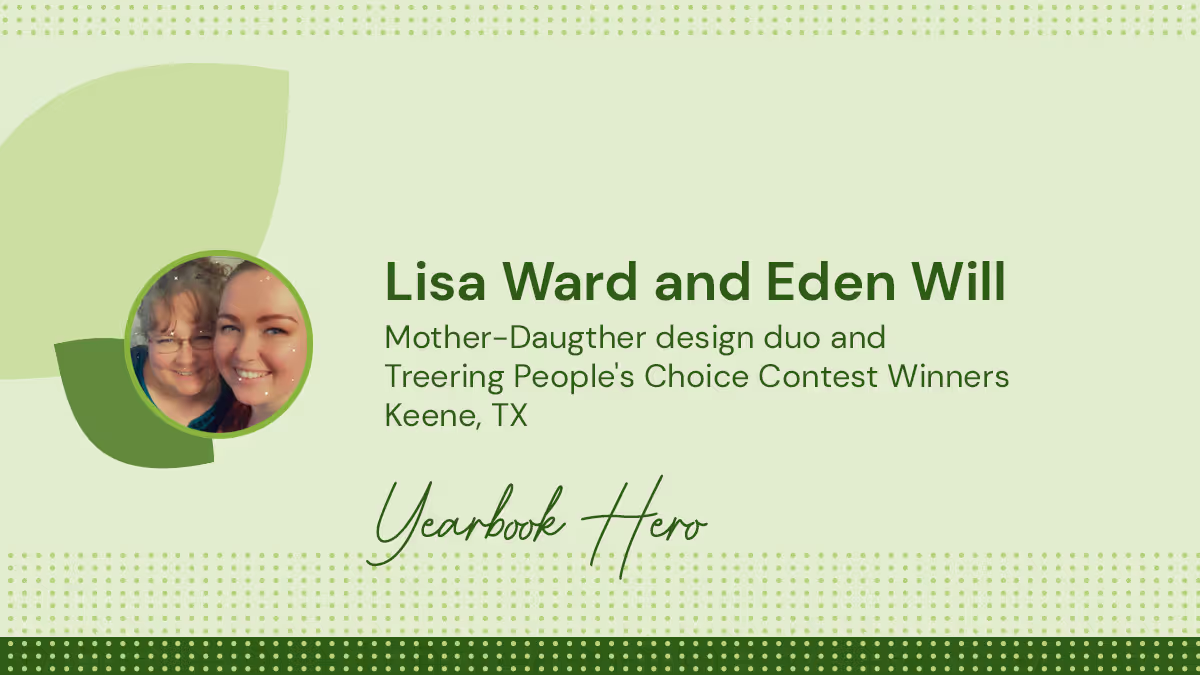
Yearbook Heroes Lisa and Eden remind us what matters most
Treering Yearbook Heroes is a monthly feature focusing on yearbook tips and tricks.
As a staff member at Sycamore Academy, an online school, Yearbook Hero Lisa Ward had yearbook experience. She’s a self-proclaimed pro at the literal cut-and-paste, handcrafted memory books. As a first-year Treering user, she was excited to see students come together virtually to craft and sign each other’s books. With her daughter, Eden, she spent hours looking through templates and art in the Treering library to spark an idea for her own custom pages. The end result was the winning combination of mother-daughter talent, as Eden Will (“She’s the artist,” said Lisa) stepped in to help her mom create an entry for the People's Choice Custom Pages Design Contest.
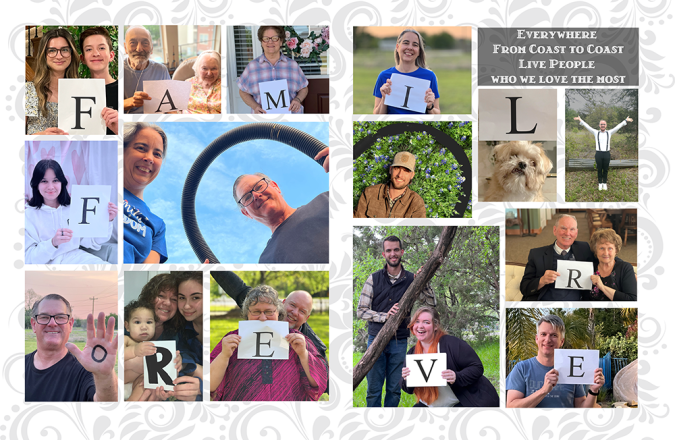
Traditionally, custom pages put an additional spotlight on one child. Tell me about putting the spotlight on your support system.
Eden: Mom asked for help.
Lisa: Eden drew out the layout.
Eden: It was a snapshot of the family for the year since we don’t have albums. My cousin just had a baby and now we have a record of this moment in our lives. We have family from CA, to MI, NC, different parts of TX, and OK. After it was finished, we ended up editing it for the participants to include their families so they had their own version. They’ll print for their families.
Why do you think the message of “Family Forever” resonated with hundreds of people on social media?
Eden: That was pretty awesome. The resonating thing is that we reached out to family we don’t always get to see. And they were all interested in being a part of this. It is so hard to get everyone together. The last time I saw everyone together was at my wedding. It was cool to collaborate virtually and make something that will last. Other people found that touching. We live in such a spread-out world.
Lisa: You get the occasional family settled in one place. Technology brings us together.
Eden: We participated in it, even though we weren’t physically together. It’s like we worked together to be together.
What value do custom pages give you?
Lisa: It’s especially helpful for our school. As an online school, we try to get pictures of people during spirit week wearing hats or different colors. We don’t have pictures of kids interacting because we are online. The custom pages help each parent take each and make it their own.
Eden: Even though she’s not a parent of a student, she was able to make it a memorable for this moment in time to make it personal for her.

5 yearbook volunteers to recruit
The first step in creating the perfect yearbook is recruiting your ideal yearbook volunteers. In a perfect world, each group member will bring a unique set of strengths to the table while working cohesively with one another. We’ve identified five personality types to consider as you begin assembling your “dream team,” along with best practices for guiding them along the path to print-ready.
1. Mom-a-razzi
There may be a parent or two on campus with professional photography experience, and that’s super. It’s no longer a requirement with many smartphones. For the scale of your yearbook project, you may need a class or grade parent (think an old-school journalism beat).
These parents are taking photos already, so you’re not challenging them beyond a simple, “Please take photos of other people’s children.”
Remember, you can easily build a yearbook if you have the content.
2. The Gatekeeper
If your team is not comprised of students and fellow staff members, you need an on-campus stakeholder on the VIP list. This person will be able to get you the inside scoop on school happenings, including the best way to sneak into classrooms for academics photos or how to set up shared photo folders with the faculty.
3. The Social Maven
Part yearbook hypeman, part yearbook marketer, this person will be in the know: stories, events, and students. She will take care of your sales campaigns and make sure everyone knows how, when, and where to buy the yearbook.
4. The Type-A Virgo
Do you want your yearbook to have a cohesive look? Do you want pages proofed and copy-edited? The Type A Virgo is your go-to for organization and project management.
5. The Cruise Director
While this yearbook volunteer isn’t the captain of the proverbial ship, his role as designated fun officer is clutch. He’s collaborating with the Social Maven on your next marketing campaign and coordinating a yearbook distribution party with school staff. (More than likely, this person is also in charge of several other committees to build community and school spirit.)
Managing Yearbook Volunteers
Now that you’ve identified your dream team, here are a few tips for managing the workload.
1. Create and Communicate the Plan
Build a project plan to determine your deadlines, tasks, and roles. We love beginning with a yearbook ladder to identify coverage and determine the yearbook page count.
2. Follow Up, Follow Up, Follow Up
Monthly check-ins, volunteer work nights, and ongoing communication help ensure the job you started will be completed. We’ve heard from volunteers that they feel their work is valuable with regular communication and seeing their contributions in action. Because their time (and yours) is valuable, make sure communications
- Are timely: give yearbook volunteers what they need when they need it. Only the Type A Virgo needs her March responsibilities on September 14 (and we love her for it).
- Have a set goal: predetermine the action(s) the team should take as a result of your communication. Do you need responses for the potluck or help tagging photos?
- Demonstrate appreciation: while I’ll never grow weary of hearing I’m awesome, meaningful feedback resonates much more. In your communications, try to highlight contributions often (e.g., “Because of all the Fun Run photos Tameka and Evelyn uploaded, Javier is now designing the layout! Thanks, team!”) and show how they benefit the yearbook.
3. Celebrate Often and Address Problems Early
When pages are locked, celebrate! When portraits are uploaded, celebrate! These festivities can be as simple as meeting for coffee after drop off or a dessert night in someone’s home.
Conversely, if things aren’t working out, be like Vanilla Ice and solve it.

Advice for dealing with complaints
When a parent, staff member, or student approaches with a complaint about the yearbook, it can be challenging not to react or take it personally. Common yearbook complaints range from missed order deadlines to incomplete coverage (e.g., “I’m not in the yearbook enough”), and typos. Taking the right approach will help you validate the concern and move to a proactive solution for your yearbook program.
Listen to the Complaint
“Take a deep breath, remain calm, and remember it's not personal,” Abby Oxendine, Treering’s Community Advocate Team (CAT) Director, said. “The person is angry with the product, policy, or process, not you.”
Give the person making the complaint your full attention and listen carefully to what they have to say. Allow them to express their concerns without interruption and empathize with their situation.
“The reality of their concern is real to them,” Yearbook Hero Chris Frost said. “It is important to understand that while your world includes every student, to the parent their kid is their world.”
Ask for Specific Details
Ask the person to provide specific details about what they're unhappy with in the yearbook. This will help you to better understand the issue and to determine the best course of action. Oxendine suggests summarizing their main points in a confident, positive tone to show you are listening. This also ensures you know exactly what the complaint entails.
Sample starter sentences include
- "I understand your concerns…"
- "Thank you for sharing your concerns with me…"
- "We will do all we can to fix these issues..." (Only use if you can fix the issue, e.g., ship a yearbook home to someone who missed the original deadline.)
Offer a Solution
Frost said, “Sometimes just being able to express the frustration is resolution enough. They may not want your solutions, just to voice their concerns.”
In the case a solution is warranted—and feasible—commit to what is possible. If you set a follow-up action, make sure you call or email back by the scheduled time. It’s important at this stage you never overpromise.
Document the Complaint
Recording the complaint and the steps you took to address it will help you to track patterns and improve future yearbooks for future editions.
Follow Up
Send a follow-up email detailing the resolution. You might even consider offering the student or parent a position to help the yearbook team to help avoid issues in the future. This will show that you care about their opinion and are committed to improving the yearbook.
Personal anecdote: I had a teacher complain once about the portrait section who became the official portrait proofer for the yearbook.
Avoiding the Top 3 Yearbook Complaints
When your hard work is on display and is a lasting keepsake, you want it to be the best reflection of your school community and your yearbook team. Here are ways to avoid the big three.
1. Missed Order Deadlines
We know: you sent emails, used a school-wide robocall, posted on social media, made a viral video with your principal, and someone still didn't know when, where, or how to order the yearbook.
How Treering Can Help
"Volunteering to create my kids’ yearbook is a lot of work, but with Treering I never worry about the outcome. I know Treering will help me anytime a problem arises."
Erin M., Treering Yearbook Specialist and elementary school yearbook coordinator
- The integrated marketing suite in each Treering account allows editors to send purchase and customization reminder emails, order free flyers, download social graphics, and share purchase links.
- Never tell a parent or student no again: your storefront is always open, and they can purchase an old yearbook, even years later.
- Mix up your marketing campaigns with our social calendar.
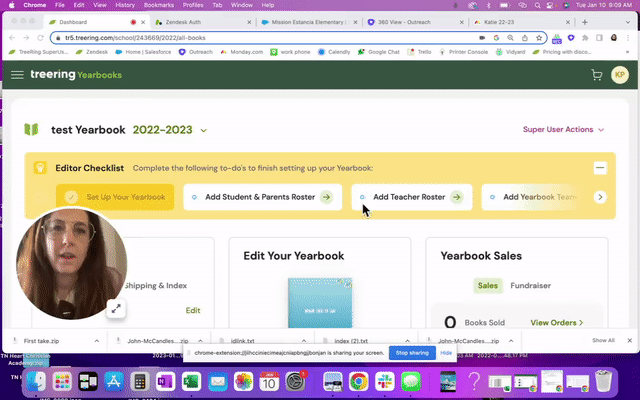
2. Incomplete Coverage
Some parents and students may feel that the yearbook did not adequately cover certain students, events, or activities. To ensure that all events and activities are adequately covered in the yearbook, you can create a detailed coverage plan when drafting your ladder at the beginning of the year and assign staff members to cover each event.
Consider adding a note to acknowledge those who did take advantage of the opportunities to submit content and photos. (This is also a subtle reminder parents and students had opportunities throughout the year to be more involved in coverage.) A simple “Thank you parents and students who shared their photos and completed our surveys. We love telling your stories.” will go far.
How Treering Can Help
- Shared folders provide your stakeholders with opportunities to share their photos. Yearbook Hero Lauren Casteen uses these photos that the yearbook staff may have missed, such as a band event hours away.
- Community portraits allow parents the opportunity to upload a portrait of a student who may have missed picture day or joined in the second semester.
- Tag your photos and monitor coverage with the index report, a real-time listing of who is in the book.
- Parents and students can tell the story of their year with custom pages, two free pages that appear only in their copy of the yearbook.
2. Missing or Incorrect Information
One of the most common complaints is when a student's name, photo, or information is missing or incorrect in the yearbook.
When applicable, remind parents that this is a student-published item, while you do your best to facilitate the book, students have creative control and lead how the book is done. It’s their homework that is on display for a lifetime.
If it’s a volunteer job to create this living, breathing historical document of life for hundreds of kids at a moment in time. That is a heavy burden to carry alone. (Most professional journalists work in a team!)
“Parent volunteers have enough on their plates with being good parents, spouses, employees of their jobs, and volunteers to boot! Having to field phone calls from confused parents shouldn’t be another feather in their cap—unless they want it.”
Katie P., Customer Success Manager and elementary school yearbook coordinator
Yearbook Disclaimer
Even the New York Times has a disclaimer. The yearbook colophon is a great place to add yours, whether you are a volunteer army putting together the book or a group of student journalists. It can be as simple as "We have done our best to ensure the accuracy of the information in the yearbook and apologize for any errors."
Tips for Next Year
To proactively combat errors, you can check your records and the student's school records to ensure all the information is correct. Another resource is the ever-changing school calendar.
Treering’s Customer Success Team recommends having a second set of eyes proof your book. If that’s not possible (we know a lot of yearbook heroes who do it solo), walk away for a few days then come back fresh. It's hard to see these little mistakes when you have been staring at the book for days.
How Treering Can Help
Remember, the key to handling complaints about the yearbook is to remain calm, professional, and focused on finding a solution that works for everyone. By addressing complaints positively and constructively, you can improve the yearbook and build trust with your yearbook stakeholders. Remember, in the end, you cannot please 100% of people 100% of the time.

5 graduation photo and caption ideas
It's that time when end-of-the-year events on campus dominate our social calendars and social feeds. Whether you're doing a quick post-ceremony graduation photoshoot with friends or snapping last-minute custom page poses for the yearbook, here are five graduation photo ideas plus some fun Instagram captions to use. I met up with my neighbor, Avery who is a high school senior, varsity athlete, super babysitter, and future marketing professional for these video tutorials and inspirational photos.
Remember, the best photos are the ones that align with your personality.

Pose 1: Looking Forward to Looking Back
A simple graduation pose you can do pre-ceremony is the over-the-should smile. Set a "mark" for your subject to do the look so you can focus there. The concrete in front of the school helped us time the shots. Unless you use a telephoto lens on a proper camera, ensure your background is more interesting than that parking lot.
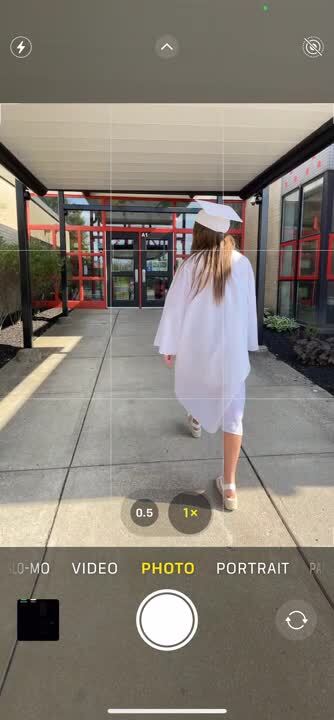
In the video above, notice the multiple flashes. This means the cell phone is on "burst" or "multi-shot mode" which gives you more options with which to work.
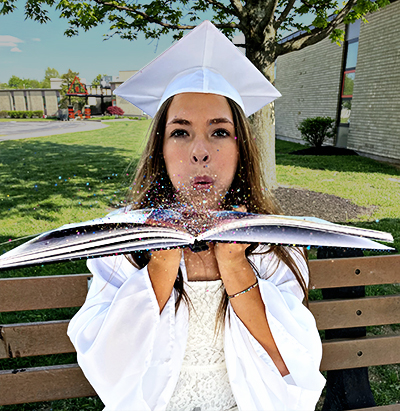
Pose 2: All That Glitters
Your first day of grade school probably involved some glitter, so why not celebrate the final day of grade school with it?
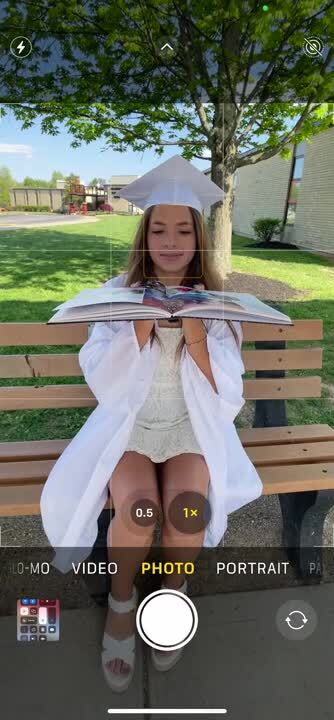
During the shoot, Avery and I found coarse glitter has more movement and picks up better with a cell phone. (It still wasn't fun to clean up.)

Pose 3: Portrait Perfection
Portrait mode on a cell phone improved our Insta-presence by adding depth to photos.

To get the most from portrait mode, add space between your subject and the background. I had Avery lean against the wall in a relaxed standing pose. at an angle. The angle allowed for the mortar lines (leading lines in photography) to draw the viewer's eye to her face.
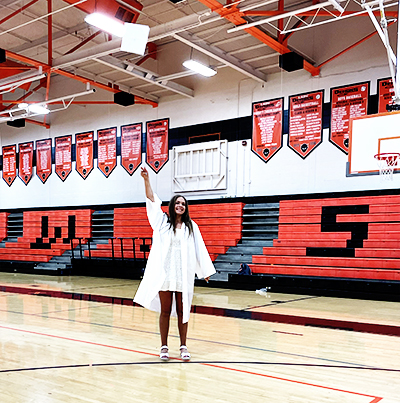
Pose 4: MVPose
The cap toss is the image most of us think of when we picture graduation. Using burst mode, snap several photos of your senior doing his/her own version.
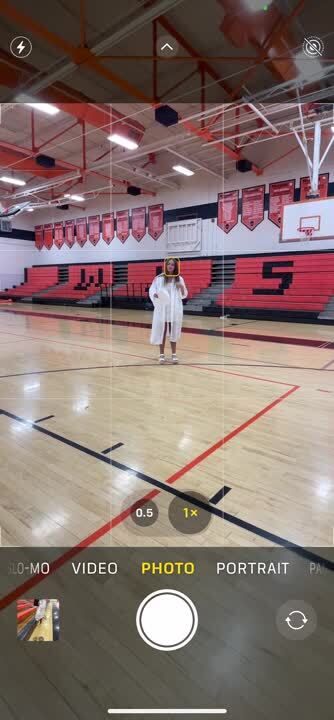
Because yellowish-green gym lighting is notoriously tricky, you'll want to use your in-camera photo editor to reduce the warmth and add a slight coolness to the tint. This pose also works well on the football field because there is plenty of overhead clearance.

Pose 5: Cap It Off
Remember our discussion of depth of field and portrait mode? Another application is for the cap. Many students decorate theirs, so make it the focal point of an image.

In the video, you can see how raising the phone just a bit flattered Avery more. My yearbook adviser always said, "Zoom with your feet," and it's stuck with me decades later.
Tips to Capture a Great Graduation Photo
Because authenticity goes a long way, here are a few ways to make the poses below your own.
- Try to avoid stiff or unnatural poses. Instead, move around and experiment with different angles until you find a pose that feels comfortable and looks good.
- The background of your photo can add interest and depth to your pose. Look for interesting locales that complement your outfit and pose. Off-campus, visit community murals, local landmarks, and parks as your graduation photo spot.
- Props can add visual interest and help tell a story in your photo. Consider using props like sports equipment, a yearbook, confetti, or a graduation cap.
- Experiment with different angles to find the one that flatters you the most. Try shooting from above, below, or at eye level.
- You can sit, stand, jump, walk, or even lie down for your senior photo.
If you're saying cheers to the end of an era and the start of a new one, may your memories be filled with joy.
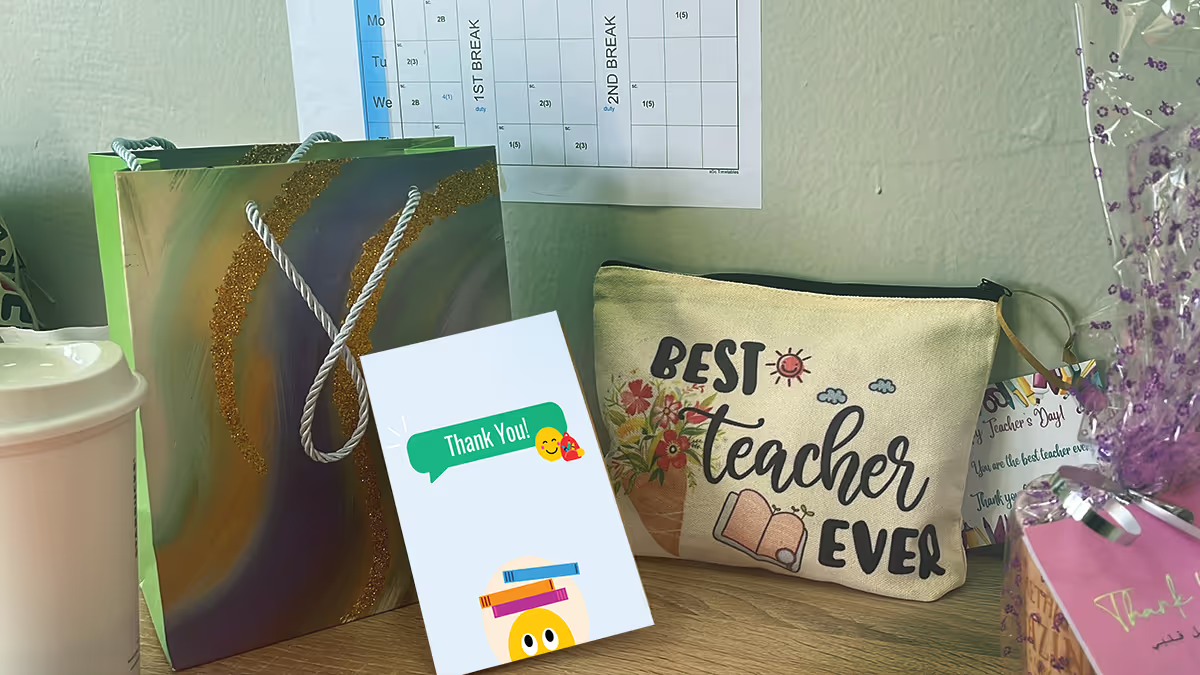
Teacher appreciation printables
By participating in Teacher Appreciation Week, students and parents recognize the efforts of their teachers. We’ve created two free printables to help make it easy because this week can be a powerful way to build rapport between home and campus life, which can ultimately enhance the learning experience for everyone involved. Additionally, participating in Teacher Appreciation Week can teach students the importance of showing an attitude of gratitude.
The Science Behind Being Thankful
Studies show that when you share gratitude with others, your brain becomes re-wired in a positive way. Gratitude helps you
- Feel happier: Gratitude can make you feel good by making more of the happy chemicals—dopamine and serotonin—in your brain.
- Think better: Gratitude can help you use the prefrontal cortex (thinking part) of your brain more, which helps you make good decisions and solve problems.
- Reduce stress: Gratitude can help you worry less and feel less scared by calming down the part of your brain that makes you feel anxious.
Now that’s something for which to be grateful.
Free Printables
We made these printables available as a convenient way for parents to participate in Teacher Appreciation Week. Simply download and print the materials from the comfort of your own home for your child or work with other classroom parents to cultivate a display on the classroom door in the teachers’ lounge. Whichever you choose, you and your child can personalize the messages, which can make them more meaningful and memorable for the teacher.
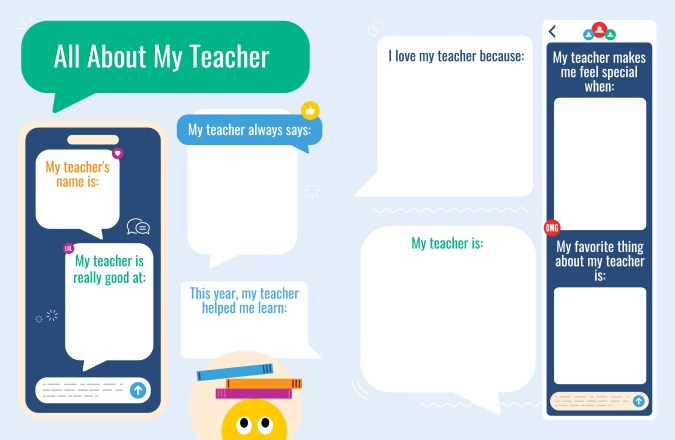
"All About My Teacher" Printable
This full-color mini poster with fill-ins is a fun way for parents and their children to document the impact of their teacher. Download it here. (Did you know this page is also available as a pre-designed yearbook spread you can drag and drop into your Treering yearbook?)
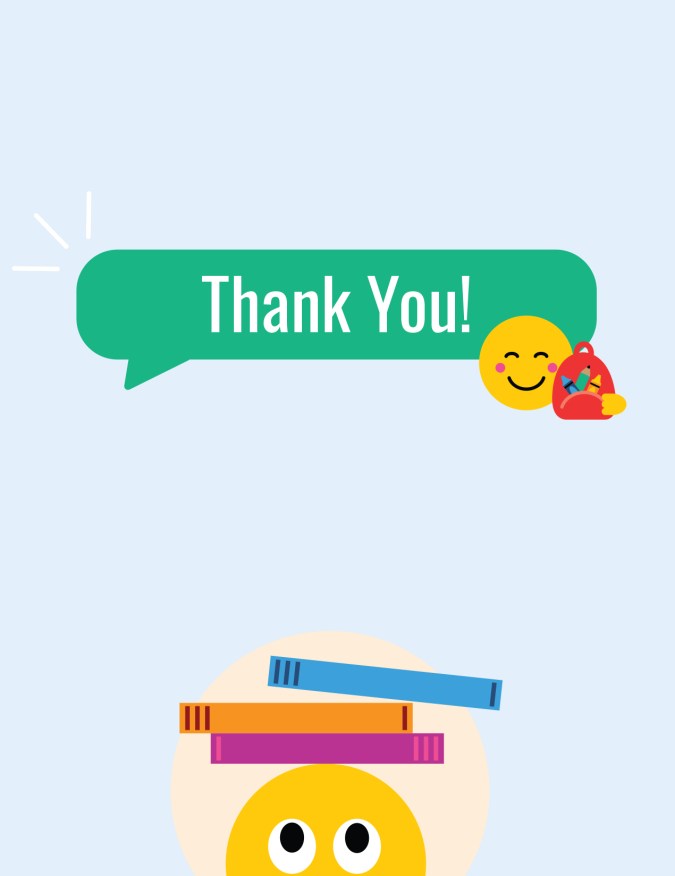
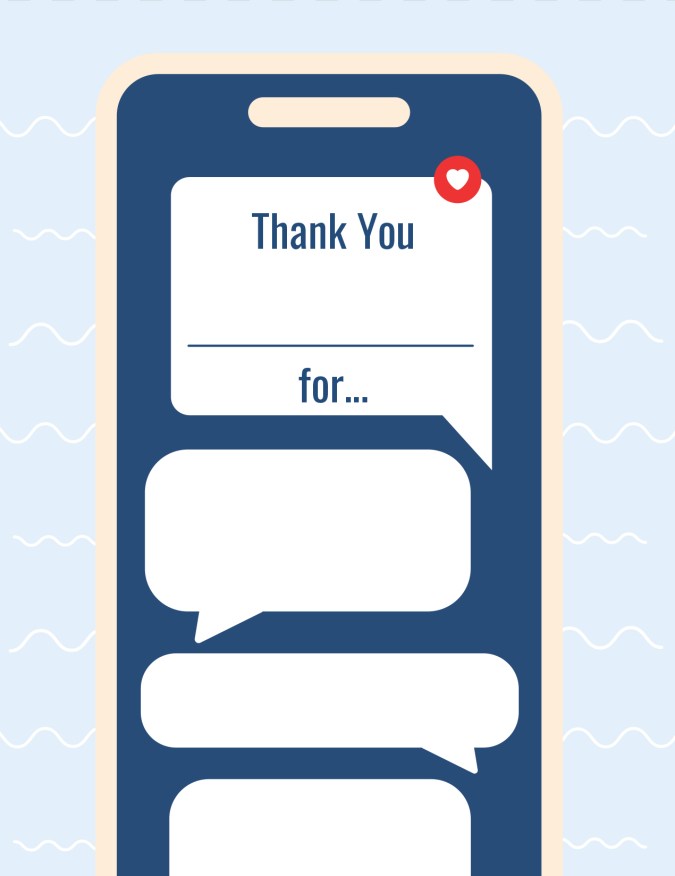
Teacher Appreciation Card
We’ve made it easy to write a letter thanking teachers for all their hard work and dedication. Fill in the blanks of the card below. Thank you cards can be compiled into a scrapbook or displayed in the classroom. Download it here.
We hope these printables help to create a fun and festive atmosphere in the classroom. Teacher Appreciation Week is a way for students and parents to express gratitude towards the teachers who have had a positive impact.
We see you, teachers; your hard work and dedication are recognized and valued.
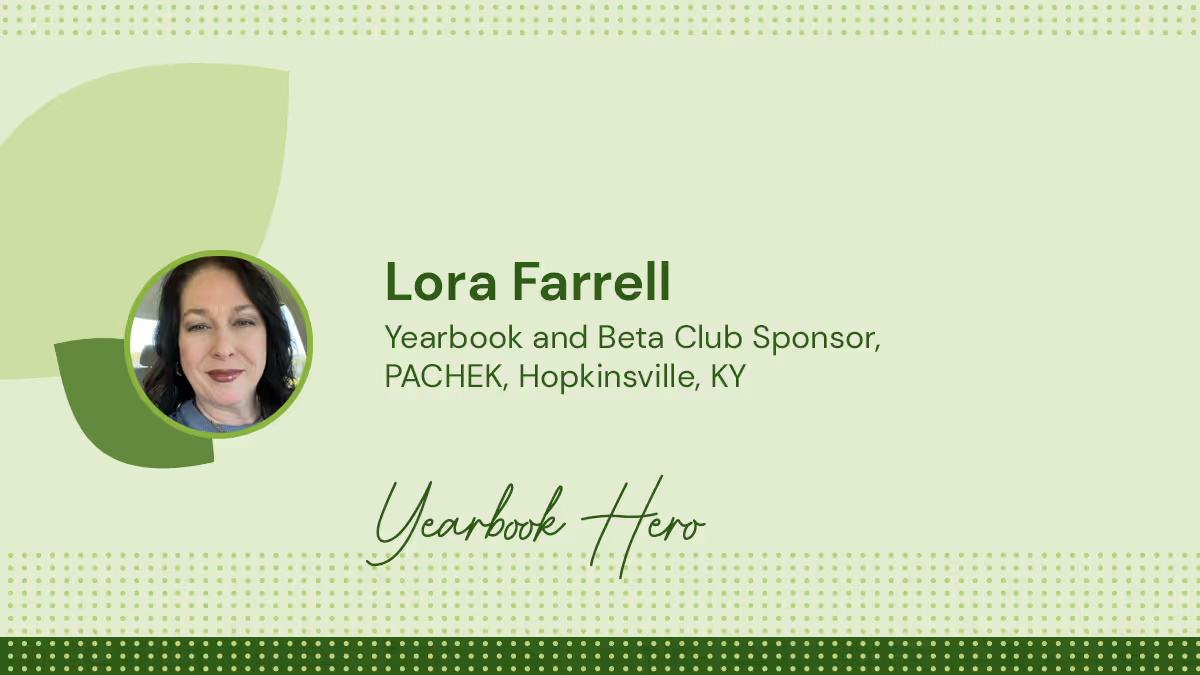
Yearbook Hero Lora Farrell
Treering Yearbook Heroes is a monthly feature focusing on yearbook tips and tricks.
One of the 18 tornadoes crossing Kentucky in December 2021, an EF-4, the deadliest tornado in the Commonwealth's history, devastated towns in the southwest corner. Pennyroyal Area Christian Home Educators of Kentucky (PACHEK) students delivered food, assisted with clean up, and served with various faith-based relief organizations in Pembroke, Mayfield, Bremen, and Dawson Springs, KY. Yearbook volunteer, pastor’s wife, and homeschool mom Lora Farrell first caught our eye when she submitted her yearbook team’s spread, detailing both the devastation and the work to right it all in the 2022 Treering Design Contest. They won second place.
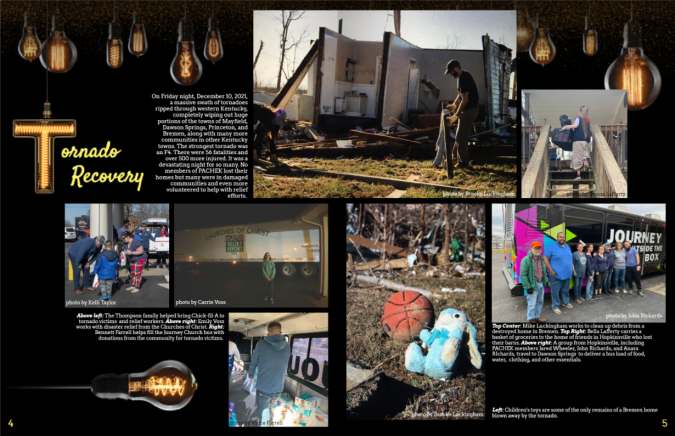
How does it feel to go from second place to first?
That was really shocking because I almost didn’t even enter. I really loved the spread we entered last year and I felt there wasn’t a spread this year (yet) at the same level of my personal satisfaction. It was such a fun surprise to be a finalist.
We are leveraging the free yearbooks we won from the contest to incentivize donations for our Beta Club fundraiser. We are partnering with Funds2Orgs for a shoe drive. We collect shoes, and they pay us per pound. The shoes then help micro-entrepreneurs in developing nations build their businesses and the money we raise will help students attend Beta’s national convention.
Let’s talk design. How did PACHEK choose Groovy for their 30th anniversary book?
The students really liked the design and we wanted to do something throwback. It’s not 90s, but the 70s seem to cycle back through every 20 years or so and it just works.
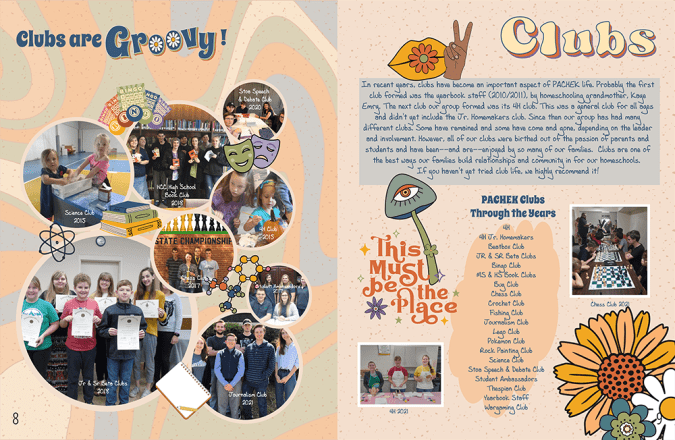
On our divider pages, we used photos from previous years along with a paragraph with a little bit of group history. The team and I reached out to older members of the community. Because we are near Ft. Campbell, there is a large, transient military population. It was tough to get some photos as a result. Most are the ones I’ve taken over the previous 12 years. We did include interviews with older members of the community since digital photos weren’t the norm back then.
How do you build a 124-page book in a homeschool environment?
Yearbook is strictly a volunteer job. We currently have four students who build the book and two moms training to take over as sponsors. As part of our campus culture, there is naturally lots of photo sharing in the group: people share at the end of the day or after a field trip—it’s automatic.
During each co-op module, we meet twice a month. Between these sessions, it’s once a month. We break down tasks throughout the year to curb procrastination. I leave notes on the spreads in the Treering app. The students are intrinsically motivated and I like to give them a little extra with parties and food during work sessions. We also do a year-end celebration when the book arrives.
What tips do you have for someone just getting started as a yearbook club adviser?
Don’t be afraid: the software is user-friendly and there are resources available. With our previous company, I had to use a lot of outside resources. In Treering, I can set margins and page styles. I love the new folder features where we can add subfolders and share between folders.
The biggest thing is to be consistent throughout the year by managing the workload.

Teaching yearbook: making a marketing plan
You’ve heard the adage, and likely uttered it yourself: fail to plan, plan to fail. That advice works whether you’re saving for retirement or just trying to get yearbooks in the hands of students across campus. It’s also why you need a yearbook marketing plan (and all the free tools below). It may seem backward to start marketing a book that hasn’t been finished yet but this is the best time to create a plan and put it into action.
Three Ways to Start Your Marketing Plan
1. Set Your Goals
SMART Goals are prevalent in the ed world. My favorite principal once said, “We tell students they can achieve anything. But if I want to be an astronaut, I can’t just go into space tomorrow.” (There’s that planning need again.)
Reverse engineering the school year and yearbook production cycle will help you achieve your goals.
Here are some examples of SMART goals:
- Sell XX amount of yearbooks by November 15th
- Increase Recognition Ad sales XX% by April 15th
- Increase all Yearbook sales XX% by May 30th
2. Create a Calendar with Important Dates
We created this yearbook marketing calendar so you can plot important dates while creating a schedule that fits your school (and your sanity).
3. Recruit Your Team and Delegate Tasks
For each campaign, spread out the responsibilities. Using a marketing campaign template will help you stay organized by listing the budget, design development, communication modes, important dates, and who is responsible.
Customize Your Yearbook Marketing Plan
Know your audience. Toastmasters has been preaching this one sentence since 1924 and it’s worked out well for them. Determine who wants what you are selling and why. Below, we've literally taken a page from Marketing Unstumped, Treering’s guide to yearbook marketing.
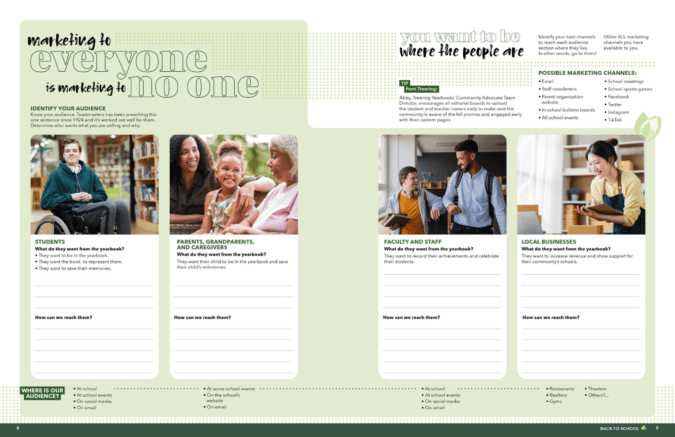
Because the same message will not resonate with everyone, you want to spend time understanding what the message is for students, parents, faculty, and local business owners. Then, go find them.
Identify your best channels to reach each audience section where they live. In other words, go to them. Utilize all the marketing channels you have available to you and evaluate which ones work best for which audience. Possible marketing channels include:
- Staff newsletters
- All-call services
- Parent organization website
- In-school bulletin boards
- All-school events
- School meetings
- School sports games
- School arts events
- TikTok

